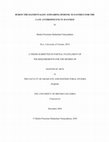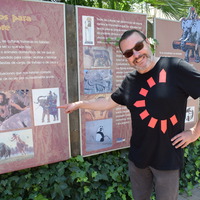Papers by Shalini Nanayakkara
The Green Prison and the Iron Tower: The Roles of Susanna Moodie and Archibald Lampman in Constructing Canadian Society and Literature
Shalini Nanayakkara's essay The Green Prison and the Iron Tower: The Roles of Susanna Mo... more Shalini Nanayakkara's essay The Green Prison and the Iron Tower: The Roles of Susanna Moodie and Archibald Lampman in Constructing Canadian Society and Literature, edited by Jonathan Hersh, argues how Moodie and Lampman use their writing in order to reflect on the societal issues of Canada within their respective periods" (Craighead 7). 
The Green Prison and the Iron Tower
With Caffeine & Careful Thought, 2017
Front Matter Vol. 4
With Caffeine & Careful Thought, 2018

In Ecology without Nature, Timothy Morton asks, "The time should come when we ask of any text, 'W... more In Ecology without Nature, Timothy Morton asks, "The time should come when we ask of any text, 'What does this say about the environment?'" (5). I believe it is now time to consider Lord Byron's 1817 dramatic poem Manfred, precisely because few scholars consider Manfred, or its author, for their discourses on nature, the elements, and environmental ethics. Mainstream environmentalism understands eco-action as moralistic and tied to the joy we feel when we experience nature, understandings that were founded in Romantic poetry. But how do we read Romantic poetry-and indeed, nature itself-when nature makes us feel guilt, anger, and fear, in conditions now popularly known as solastalgia, climate anxiety, or eco-anxiety? I propose that "Byronic nature" considers how negative emotions inform our perceptions of nature, our complacency toward and complicity in global webs of exploitation, and our inability to create systemic environmental change.

Introduction: Monster Studies
University of Toronto Quarterly
‘‘Monsters,’’ Jeffrey Jerome Cohen argues in his introduction to Monster Theory: Reading Culture ... more ‘‘Monsters,’’ Jeffrey Jerome Cohen argues in his introduction to Monster Theory: Reading Culture (1996), ‘‘always return’’ (20). Among other creatures, Cohen focuses on two (re)visitants that span the Middle Ages to the present day: from the giant ogre of Mont Saint Michel that King Arthur slays to the xenomorphs of Ridley Scott’s Alien film franchise. King Arthur, Cohen contends, is doomed to (re)slay the ogre with each interlinked retelling of his legend: in Geoffrey of Monmouth’s Historia Regum Britanniae (The History of the Kings of Britain) (1136), in the poet Wace’s verse history of England Roman de Brut (1155), which draws heavily on Monmouth, in Layamon’s Brut (The Chronicle of Britain) (1185–1216), which, as it draws on Wace, also echoes Beowulf’s fight with Grendel, and in Thomas Malory’s Le Morte d’Arthur (1485), to offer only four reslayings and re-tellings.1 Moreover, the gene that characterizes monsters’ recursiveness as a popular cryptozoological species in history, literature, and mythology sees the ogre routinely appearing prior to and after these medieval (re)incarnations. Similarly, in the Aliens trilogy (1979–1992), Ripley (played by Sigourney Weaver) battles the xenomorph queen and her ever-expanding brood, an acid-blooded, parasitic species that spawns prolifically. In true monster fashion, in which monsters be-monster more of their kind, the monster-verse of seemingly unkillable aliens has produced more progeny since the 1996 publication of Cohen’s Monster Theory: a fourth film appeared in 1997, and Scott has more recently released two prequels (Prometheus in 2012 and Alien: Covenant in 2017). Additionally, this monstership of movies propagates an ever-expanding fleet of comics, novels, role-playing games, and video games. The trilogy becomes a tetralogy, then monstriferously voluminous. The articles in this special issue on ‘‘monster studies’’ have more concrete origins and fewer and decidedly less frightening incarnations than the Mont Saint Michel ogre and the Alien xenomorphs, but they nonetheless have gone through several transformations – all of which speak











Uploads
Papers by Shalini Nanayakkara